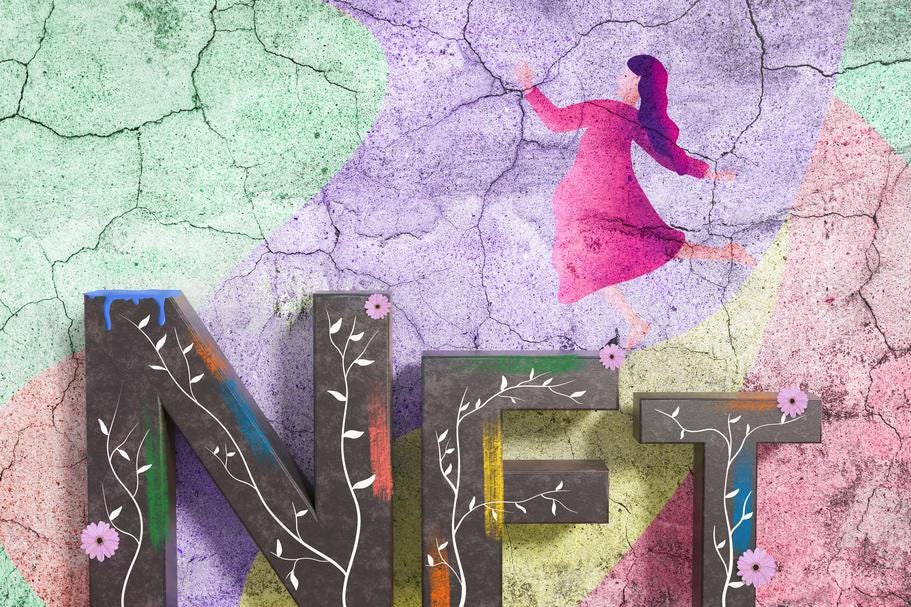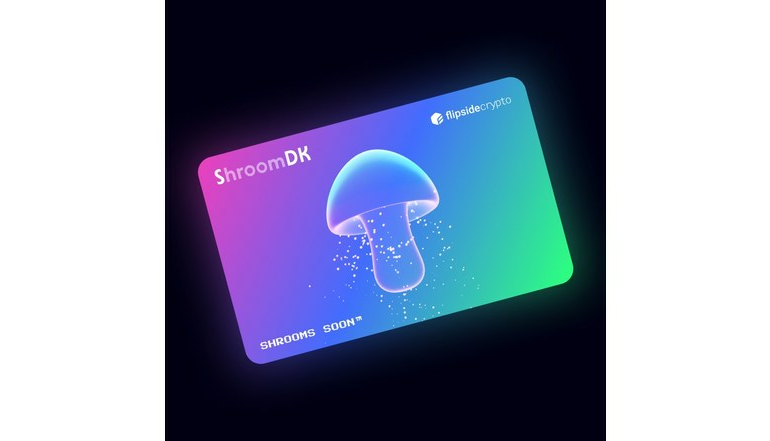Social media and personal brands are combining in the exploding world of NFTs.
Agency and ownership are often discussed in the education space as essential aspects of learning for students to embody. As a result, entrepreneur programs are on the rise to activate a mindset many see as necessary to succeed in an accelerating world of possibilities.
Many Millennials were raised in the era of do what you love, and the money will follow, made famous by Marsha Sinetar. However, as a recent New York Times NYT article suggests, many Millennials have real money concerns as their earnings potential appears far less than their Baby Boomer parents. Even though they represent one of the most educated and diverse populations, rising housing costs, student debts, and inflationary constraints hamper their growth potential.
Rather than buying into the real world investment strategies of a volatile stock market and high real estate costs, some are turning to the virtual world as their most hopeful avenue for growth. With the uncertainties of crypto-related markets, the idea of ownership seems more attainable in the new world economy of virtual transactions, from non-fungible tokens (NFTs) to other subscriber-based possibilities.
As Millennials take on the ownership of learning in their post-academic lives, they are turning their gaze toward entrepreneurs in the digital space that can provide answers to their uncertain economic futures. Julian Rodriguez is one Millennial using his background in crypto markets that reaches far back to the beginning days of the Ethereum ETH project to propel a new venture of creative ownership. He is the founder and CEO of Momento NFT, a direct-to-fan NFT social network that lets fans and collectors own the best moments of content creators.
Business Wire predicts the global NFT market size will reach $97.6 billion by 2028, rising at a market growth of over 30%. Rodriguez is betting on the growth indicators as a real option for younger investors seeking to change their financial picture through ownership options that speak to their digital sensibilities. With an initial $4 million seed round for Momento NFT led by Cadenza Capital Management and others, Rodriguez is placing total to-date funding at $6 million as he looks to revolutionize how the world thinks about digital ownership.
This reporter sat down with Julian Rodriguez to learn about his path to Momento NFT and his views on the changes in mindsets and outlooks among younger generations. Few people have ridden the waves of early crypto into its present manifestations as much as Rodriguez. A new world is emerging where physical reality takes a back seat to virtual, and it will take people like Rodriguez, with his vast background and experience, to drive the vehicle.
A Crypto Background
Rod Berger: Explain the early days and how your career experiences transformed your thinking of engaging in a social media platform-based model of Momento NFT.
Julian Rodriguez: The story encapsulates the beginning of crypto. In 2013, I met Vitalik Buterin, the co-founder and creator of Ethereum, and ended up working with him at Bitcoin BTC Magazine. I coordinated a lot of the magazine’s distribution in and around New York City. Vitalik released the Ethereum white paper in the magazine, and I was one of the first 20 people to review it. So I had a front row seat of what this world would be like.
I was in the buzz of it all and one of the first Application-Specific Integrated Circuit (ASIC) miners with box number 68, but I didn’t have the foresight to buy more than one at that time [laugh].
In 2014 Vitalik went down to the conference in Miami to unveil his Ethereum project to the world, where the first 20 co-founders were declared. He called me in a Facebook movie moment and said,” Hey Julian, you should be here.” But unfortunately, I wasn’t prepared to just up and move to Miami from New York.
Soon came the crypto apocalypse, and the New York Bitcoin Center closed down. Man, it was lights out. Everyone was scrambling, and Vitalik left the US, focusing on Europe.
I turned my gaze to Silicon Valley to understand how people are scaling companies and building sustainable tech. Then, in 2016, I started my first venture backed startup, which had nothing to do with crypto. Instead, it was a B2B wholesale marketplace, making me a better entrepreneur.
By 2020, after listening to people like Gary Vaynerchuk (GaryVee) to Mark Cuban predict the crypto market and seeing the TikTok explosion and people spending more time online, it was clear that the timing was right to get back into it. I’m probably one of the few who have seen all the crypto ups and downs, why they work and don’t, and how the market is shaped. I knew I had to bring in my past roommate at Fordham University, Sudesh Banskota as a partner, and Momento NFT was formed.
Berger: Why Momento? What was the differentiator in deciding to launch the NFT social platform?
Rodriguez: All roads lead to Vitalek, right? He believed the next stage of Ethereum was going to be social, but it never got off the ground. There should have been social programs for Ethereum. Instead, there were super high technical projects that had nothing to do with what people wanted to do on social media. A lot of it is also waiting for the blockchains to get to the right point. Ethereum, in its current iteration, was not the best place to do that. You couldn’t scale a social media platform on top of Ethereum.
Then in 2020, you saw the advent of a bunch of blockchains. At least 1000 blockchains that promise the scale and speed necessary. Wherever there’s interest, people are going to find a solution. Everyone was talking about and thinking about crypto in 2020, and I knew the timing was finally right because I had the momentum to influence people to make it happen.
Understanding the Model
Berger: How would I understand the success of Momento now? How many people are actively using the platform presently?
Julian Rodriguez’s insider pass to the world of Web3 and crypto fuels his latest efforts to … [+]
Rodriguez: There are 55,000 users currently, but we’re growing fast. We’re not just Web3 focused on our approach to growth. We work with Web2 (current) influencers and the creator economy, celebrities, and athletes to onboard their active Web2 audiences and show them our toolset through Web3.
It is digital ownership, royalties in owning and trading other people’s content. The utility around having an NFT unlocks a ticket, a live stream event, or some limited edition merchandise. It opens up different avenues for these influencers and celebrities to monetize the digital content they’re known for and inspire and connect with their communities. Then there are payment rails behind it, and we put everything together in one convenient package.
Berger: Talk about the celebrity angle. I believe you have a deal with the NBA, correct?
Rodriguez: It’s a split where NBA Top Shot of Dapper Labs (an NFT marketplace where sports fans can buy, sell and trade basketball video clips) does all the on-court content, and we focus on the off-court. These athletes know their value and the social currency that their content creates.
For example, LeBron James, off the court, has been doing this thing called Taco Tuesdays. A funny, short-form video went viral, and he has continued following up on the theme. They’re intimate moments with him and some of his teammates with other all-stars. LeBron knows the media value and begins to imagine, perhaps, what if he did it with Pepsi and what that number would be? The financial number far exceeds the number of dunks or jump shots he shoots. So we go in that direction. We don’t have an infinite budget, but we know the interest is there.
Our business is actually an 80-20 split; 80% of our users are people creating their own personal brands, and 20% are athletes and A-list celebrities.
Civilization Shift
Berger: Where is this transformation heading from present-day Web2 to Web3 and beyond? Where is it moving collectively, in your opinion?
Rodriguez: I have a ton of opinions about where we’re going as a civilization. The world will be a place that essentially has no difference between digital and physical spaces. Most of these Generation Alpha kids will be born into a reality where they’re actually going to be annoyed by the physical world.
They will be irritated by the sunlight, and wondering why does the tree move so much? “Where’s the reset button,” they might say. Something happens when you’re exposed to technology at a very young age. You begin to realize that another person made a machine with a preordained set of rules under which it behaves. So you’re inclined to figure that out or anticipate the breadth of what humans can do. Nothing is spectacular or fanciful anymore. You know that the machine can do a certain amount of things. Now it’s all about whether the machine is quicker than you.
Humans have never interacted with anything like that in all of civilization, which is why you see such a massive difference in how fast we’re moving and what we’re building.
Zuckerberg is pouring $10 billion into their new generation of virtual reality (VR), which is actually mixed reality (MR) and augmented reality (AR AR ). It’s about transposing digital worlds on top of your visual field of view. The physical world is overlaid with a digital effort, live interactive, digital information.
But Zuckerberg knew he had to make this out of VR gaming because it has to be fun. People aren’t going to do it just because it’s intellectually stimulating.
The Endpoint
Berger: How will these innovations change how individuals financially interact with one another and the speed of transactions?
Rodriguez: The question becomes, where do crypto and Web3 end up in this scenario? You’re going to see people getting paid by the second, and individuals will be consistently aware of the ‘value’ that you extract for the things you do on a per-second basis.
The balance will change, which isn’t dictated by the central bank. It’s yours. You have the private keys in your virtual wallet.
There will be a psychological shift. What will people do when they realize they just need to deal with another human to receive an immediate instant value transfer? You’ll never get that value unless you kill me and take my private keys out of my brain. So people are just going to do more. They will put themselves in a position to say, “Well, I can give you this right now or build it right now. Scan the PRC and send the payment.” It’s a level of human incentive we’ve never seen.
Beyond a creator and visionary in the emerging web space bringing social media platforms powered by NFTs and personal ownership, Julian Rodriguez is a compelling, energetic mind whose forward-thinking gears seem in perpetual motion.
As the world of blockchains and cryptocurrencies work out their kinks in the financial world, visionaries like Rodriguez will continue to adapt, develop and create innovations transforming the physical and virtual realms of our collective existence. No easy feat, but minds like Rodriquez appear up for the challenge.
Interviews have been edited and condensed for clarity.


